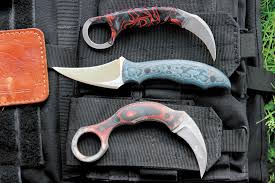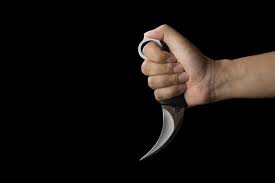The karambit training starts with the 12 point form as used in the Escrima stick forms, the angles and numbers are identical; the difference is in the way the form is trained, i.e., the stab and cutting actions applied.

Here’s a some of the key points:
- Bladed Weapons Techniques:
- Single or double-edged bladed weapons can be used for different techniques.
- The outside curve is employed in slashing manoeuvres, while the inside curve is utilized for hooking or ripping attacks.
- Thrusts can be executed using the point of the blade.
- Punching strikes can be made with the ring that covers the index finger.
- Karambit Characteristics:
- The karambit is a specific type of bladed weapon.
- It is held with the blade pointing downward from the bottom of the fist.
- The blade typically curves forward, but a reverse grip is occasionally used.
- Versatile Striking Methods:
- The primary use of the karambit involves slashing or hooking motions.
- Karambits with a finger ring can also be used in a punching motion, striking the opponent with the finger ring.
- Some karambits are designed for a hammering motion.
- Self-Defense Utility:
- The karambit’s flexibility in striking methods makes it useful in self-defence situations.
- The finger guard on the karambit makes disarming difficult.
- It allows for manoeuvring the knife in the fingers without losing one’s grip

The karambit has found popularity because the biomechanics of this weapon, highlighting the multifunctional nature of its use, in terms of slashing, hooking, thrusting, and punching motions. The adaptability of the karambit in self-defence situations, coupled with its unique design features, contributes to its effectiveness as a versatile tool for martial arts and personal protection.